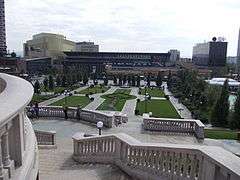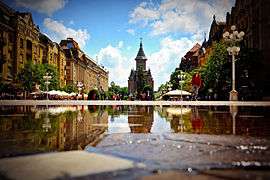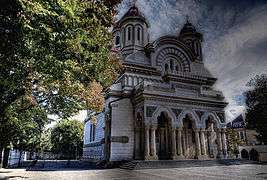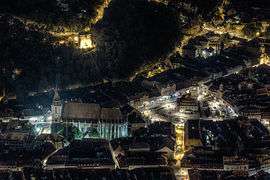Metropolitan areas in Romania
 |
| This article is part of a series on the politics and government of Romania |
|
There are 10 metropolitan areas in Romania that have been constituted as of 2013.
Legislative status
The current legislation in Romania regulates the status of the 265 cities according to their population and regional importance:
- Rank 0 – Bucharest, the capital of Romania - municipality of European importance
- Rank I – municipality of national importance, with regional role and potential influence at European level
- Rank II – municipality of national, regional or county-level importance, or with equilibrium role in the network of cities
- Rank III – cities
Legislation also restricts the possibility to engage into a metropolitan area project to only those cities that are of rank 0 or I.[1] Here is a list of the municipalities that as of 2007 can for metropolitan areas around them with approximate populations.[2] Only three zones have been officially constituted by the end of 2007: Oradea, Iasi and Constanta.[3] At least 9 others are at the level of project.
Constituted metropolitan zones
- Iași metropolitan area[4] (since 8 April 2004) – Today it has a population of 400,347[5] and 832 km².
- Oradea metropolitan area (since 9 May 2005)[6] – It had a population of 258,800 in 2008 being the largest urban area in the Crișana historical region, surpassing the city of Debrecen.
- Târgu Mureș metropolitan area (since 2005)[7] – It has a total population of 212,752.
- Baia Mare metropolitan area (since 2006) – It includes 19 localities and has a population of 237,348 inhabitants.
- Constanța metropolitan area[8] (since December 2007) – It hosts 70% of the county population, 446,595 inhabitants,[5] on an area totaling 33% of the administrative territory of Constanța.[9]
- Brașov metropolitan area[10] (since 2007) – Now has a population of 402,041.[5] It includes the cities of Codlea, Săcele, Ghimbav and Râşnov.
- Cluj-Napoca metropolitan area[11] (since 2008)[12] – In 2011, the population of the metropolitan area was estimated at 392,562, with a total area of 1,626 km².
- Craiova metropolitan area[13] (since 11 February 2009) – It has a population of 333,834.[5]
- Satu Mare metropolitan area (since 2013) – In 2013, the population of the metropolitan area was estimated at 243,600, with a total area of 1,988 km². It includes 3 cities and 22 communes.
- Piatra Neamț metropolitan area (since 2013)[14] – It comprises 2 cities and 7 communes.
Planned metropolitan zones
- Bucharest metropolitan area[15] – Today it has a population of about 2.2 million and is only slightly larger than the city proper. There are plans to greatly enlarge the metropolitan area all the way to the Danube. A possible name would be Greater Bucharest.[16] Currently, the project advances slowly.[17]
- Timișoara metropolitan area[18][19] – As of July 2006, it has a population of 387,885.[5]
- Danube metropolitan area[20] – It is formed by the cities of Galaţi and Brăila and is estimated to have a population of about 450,000. From the establishment, it will be the second largest conurbation in Romania.
- Bacău metropolitan area[21][22] – It includes the urban area of Bacău and other surrounding localities, with a total population of around 200,000.
- Ploiești metropolitan area[23] – It is made up of the urban area of Ploieşti and other surrounding localities. It has a population of more than 300,000.
- Suceava–Botoșani conurbation[24] – It includes the metropolitan areas of Suceava and Botoșani, with a total population of over 300,000 inhabitants.
Statistics
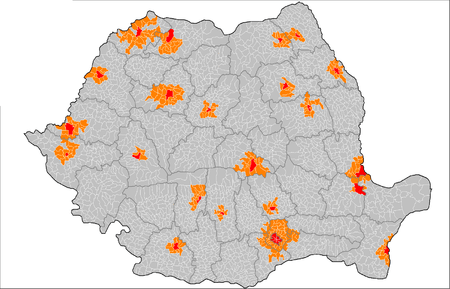
| Name | Population (2011) | Area | Density |
|---|---|---|---|
| Bucharest Metropolitan Area | 2,272,163 | 1,811 km² | 1,254/km² |
| Danube Metropolitan Area | 496,844 | 1,702.17 km² | 291/km² |
| Constanța Metropolitan Area | 425,916 | 1,013.5 km² | 420/km² |
| Cluj-Napoca Metropolitan Area | 411,379 | 1,537.54 km² | 268/km² |
| Timișoara Metropolitan Area* | 384,809 | 1,070.48 km² | 359/km² |
| Iași Metropolitan Area | 382,484 | 808 km² | 473/km² |
| Brașov Metropolitan Area | 369,896 | 1,368.58 km² | 270/km² |
| Suceava–Botoșani Conurbation | 305,060 | 1,117.46 km² | 273/km² |
| Craiova Metropolitan Area | 285,098 | 419.2 km² | 680/km² |
| Ploiești Metropolitan Area | 276,279 | 478 km² | 577/km² |
| Oradea Metropolitan Area | 235,462 | 773 km² | 305/km² |
| Satu Mare Metropolitan Area | 233,306 | 2,251.09 km² | 104/km² |
| Bacău Metropolitan Area | 216,649 | 848.32 km² | 255/km² |
| Baia Mare Metropolitan Area | 215,932 | 1,395.38 km² | 154/km² |
| Pitești Metropolitan Area | 213,212 | 446.21 km² | 477/km² |
| Târgu Mureș Metropolitan Area | 197,717 | 669.01 km² | 295/km² |
| Arad Metropolitan Area* | 191,880 | 570.23 km² | 336/km² |
| Râmnicu Vâlcea Metropolitan Area | 163,650 | 942.65 km² | 173/km² |
| Corvina Conurbation | 149,198 | 409.35 km² | 364/km² |
| Piatra Neamț Metropolitan Area | 131,086 | 706.84 km² | 185/km² |
*Timișoara and Arad intend to form the Arad–Timișoara Conurbation.[25]
Functional Urban Areas
In the EU, a Functional Urban Area (FUA) - formerly known as larger urban zone (LUZ) - consists of a city and its commuting zone. The LUZ definition was introduced in 2004 by Eurostat, as a measure of the population and expanse of metropolitan areas in Europe.[26]
| Rank | Name | County | Development region | FUA Population (2012) |
|---|---|---|---|---|
| 1 | Bucharest | - | Bucharest-Ilfov | 2,183,091 |
| 2 | Iași | Iași | Nord-Est | 382,484 |
| 3 | Cluj-Napoca | Cluj | Nord-Vest | 375,379 |
| 4 | Constanța | Constanța | Sud-Est | 369,693 |
| 5 | Brașov | Brașov | Centru | 344,892 |
| 6 | Timișoara | Timiș | Vest | 341,389 |
| 7 | Craiova | Dolj | Sud-Vest | 289,025 |
| 8 | Ploiești | Prahova | Sud | 267,575 |
| 9 | Galați | Galați | Sud-Est | 265,137 |
| 10 | Oradea | Bihor | Nord-Vest | 210,851 |
Image gallery
References
- ↑ (Romanian)
- ↑ (Romanian) "Map of Romanian cities that can have metropolitan areas - in maroon"
- ↑ Zona Metropolitană, viitorul dezvoltării urbane: Informaţia de Mureş
- ↑ Zona Metropolitana Iasi
- 1 2 3 4 5 INS INS 1.01.2009(Romanian) Archived July 26, 2009, at WebCite
- ↑ Zona Metropolitana Oradea
- ↑ Târgu Mureș metropolitan area official site
- ↑ Zona Metropolitana Constanta
- ↑ "Constanța Metropolitan Area, officially in December", Telegraf Online Constanța
- ↑ Microsoft Word - Strategie_zona_metropolitana.doc Archived April 11, 2008, at the Wayback Machine.
- ↑ Zona Metropolitana Urbana si Strategii de Dezvoltare a Zonei Metropolitane Cluj-Napoca
- ↑ "Zona Metropolitana Urbana" (in Romanian). CJ Cluj. Retrieved May 25, 2009.
- ↑ Eroare > EVZ.ro
- ↑
- ↑ Proiect - Zona metropolitana Bucuresti
- ↑ (Romanian) Zona Metropolitana Bucuresti ar urma sa se intinda pana la Dunare
- ↑ NewsReport - Zona Metropolitana Bucuresti, un proiect fara strategii si planuri concrete, uitat la sertar
- ↑ Zona Metropolitană Timişoara | Primaria Timisoara | Secţiuni | Proiecte importante ale municipalitatii
- ↑ Util: Primaria Municipiului Timisoara lanseaza o dezbatere privind Zona Metropolitana
- ↑ Zona metropolitana Galati-Braila va avea un statut de functionare peste trei saptamani - Stiri din Real-Estate pe Wall-Street
- ↑ ADL BACAU - Totul despre Zona metropolitana Bacau
- ↑ Conducere pentru ZONA METROPOLITANĂ BACĂU « Ziarul Observator de Bacau
- ↑ Administratia locala - Zona metropolitana Ploiesti prinde contur
- ↑ Victor Cozmei (20 September 2013). "Suceava și Botoșaniul vor să se unească într-un pol de dezvoltare care să rivalizeze cu Iașiul: tren de mare viteză, stadion în comun, drum expres și dezvoltarea aeroportului". HotNews.ro.
- ↑ "Studiu de potențial privind dezvoltarea la nivelul municipiilor Timișoara și Arad" (PDF). ADR Vest (in Romanian).
- ↑ "European cities – the EU-OECD functional urban area definition". Eurostat. Retrieved 2 August 2015.
- ↑ "Population at 1 January 2012". Eurostat. Retrieved 2 August 2015.
.jpg)
